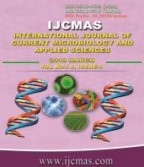


 National Academy of Agricultural Sciences (NAAS)
National Academy of Agricultural Sciences (NAAS)

|
PRINT ISSN : 2319-7692
Online ISSN : 2319-7706 Issues : 12 per year Publisher : Excellent Publishers Email : editorijcmas@gmail.com / submit@ijcmas.com Editor-in-chief: Dr.M.Prakash Index Copernicus ICV 2018: 95.39 NAAS RATING 2020: 5.38 |
The experiment was conducted at Instructional Farm Jaguli (latitude 23.56° N and longitude 88.32° E) of Bidhan Chandra Krishi Viswavidyalaya at Mohanpur in Nadia district of West Bengal during March 2017 to June 2017 to study the diversity and relative abundance of insect pollinators; and the effect of different modes of pollination on yield and yield attributing parameters of sesame. A total of 10 insect visitors belonging to order Hymenoptera (comprising of 5 species viz., Apis dorsata, Apis mellifera, Megachile sp., Vespa cincta and Camponotus sericius), Diptera (comprising of 2 species viz., Sacrcophaga sp. and Musca domestica) and Lepidoptera (comprising of 3 species viz., Danaus chrycippus, Amata bicincta and Pieris sp.) were found to visit the sesame flowers during the period of study. The abundance (percentage of insect fauna/sq.m/2 min.) of Hymenopterans (89.87 %) was maximum followed by the Dipterans (6.74 %) and Lepidoptera (3.37 %). Among them Apis dorsata was the most predominant (76.39 %) followed by Apis mellifera (7.58 %). Open pollination and honey bee pollination significantly increased the number of capsules/plant, number of seeds/capsule, 1000 seed weight and seed yield of sesame as compared to plots without any pollinators. The seed yield in open condition was significantly higher as compared to honey bee pollination. An increase in seed yield of 49.92 % and 35.23 % were reported in open and honey bee pollination respectively as compared to pollinators excluded condition.
 |
 |
 |
 |
 |